
Sphaeropteris cooperi, synonym Cyathea cooperi, also known as lacy tree fern, scaly tree fern, or Cooper's tree fern, is a tree fern native to Australia, in New South Wales and Queensland.
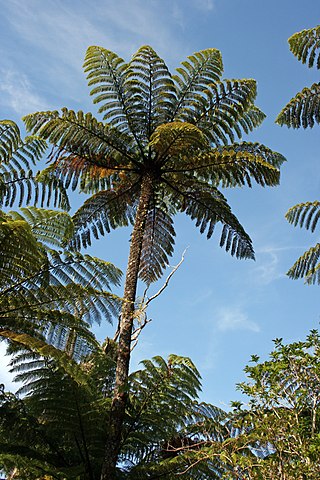
Cyathea is a genus of tree ferns, the type genus of the fern order Cyatheales.
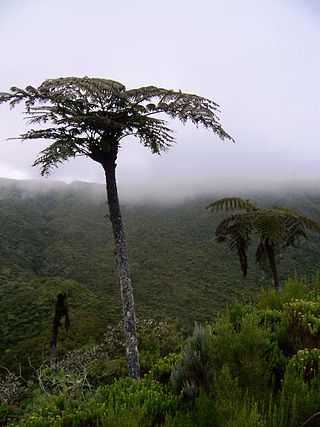
The Cyatheaceae are a family of ferns, the scaly tree ferns, one of eight families in the order Cyatheales in the Pteridophyte Phylogeny Group classification of 2016. Alternatively, the family may defined much more broadly as the only family in the Cyatheales, with the PPG I family treated as the subfamily Cyatheoideae. The narrower circumscription is used in this article.
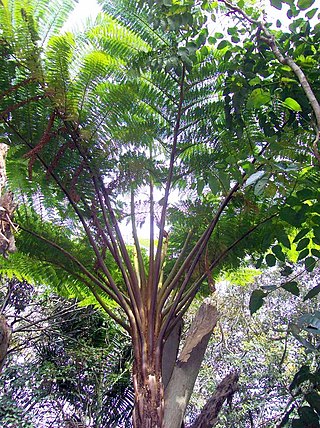
Sphaeropteris excelsa, synonym Cyathea brownii, commonly known as the Norfolk tree fern or smooth tree fern, is probably the largest fern species in the world. It is endemic to Norfolk Island, in the Pacific Ocean near Australia and New Zealand. It is named after the botanist Robert Brown (1773-1858).

Sphaeropteris is a genus of tree fern in the family Cyatheaceae. It has been treated as a subgenus within the genus Cyathea, but is accepted in the Pteridophyte Phylogeny Group classification of 2016.
Alsophila hermannii, synonym Cyathea christiiCopel., is a species of tree fern endemic to Mindanao in the Philippines, where it grows in forest at an altitude of 900–1800 m. The trunk is erect and may be 5 m tall or more. Fronds are bi- or tripinnate and 2–3 m long. The stipe is covered with some warts and narrow, brown scales. Sori occur near the midvein of fertile pinnules and are covered by thin, fragile indusia.
Alsophila engelii, synonym Cyathea elongata, is a species of tree fern native to Venezuela and Colombia, where it grows in montane areas at an altitude of 2000–3000 m. The trunk is erect and up to 11 m tall. Fronds are pinnate and usually 2–3 m long. The rachis and stipe are brown, may be smooth to warty and have basal tan scales. Sori occur in small groups towards the base of the pinnule midvein and are covered by cup-like indusia.
Alsophila lunulata refers to one of two species of tree ferns:
Alsophila crassicaula, synonym Cyathea ledermannii, is a species of tree fern native to Papua New Guinea and Bougainville Province in the Solomon Islands, where it is common in submontane rain forest at an altitude of 1000–3000 m. The trunk of this plant is erect and grows to about 3 m in height. Fronds may be bi- or tripinnate and up to 2 m in length. The rachis is purplish brown in colouration and usually bears basal scales. These scales range from pale, to brown, to bicoloured. Sori are borne on each side of the pinnule midvein. They are protected by firm indusia.

Alsophila is a genus of tree ferns in the family Cyatheaceae. It has also been considered to be a section in the subgenus Cyathea of the genus Cyathea.

Alsophila glaucifolia, synonym Cyathea glauca, is a species of tree fern endemic to Réunion. Little is known about this species.

Cyathea cranhamii is an extinct species of tree fern. It was described based on permineralised sori from the Early Cretaceous Longarm Formation deposits of Apple Bay on Vancouver Island, British Columbia.

Lophosoria quadripinnata(J.F.Gmel.) C.Chr. is a species of fern that, according to DNA molecular analysis, belongs to the family Dicksoniaceae, where it is placed in the genus Lophosoria. It is found in the Americas spanning from Cuba and Mexico to Chile. In Chile it is present in the area between Talca and Aysén including Juan Fernández Islands. In Argentina it grows only in the humid valleys of western Neuquén and Río Negro Province. Diamondleaf fern is a common name. In Spanish it is known as 'ampe' or palmilla, but one has to remember that there are several species of ferns called "palmillas" that have larger or smaller fronds, and which grow in colder climates. It is a medium-sized plant, growing to about 4–5 feet and even though the rhizome does not grow a trunk, it is clearly related to the other tree ferns due to features that were apparently already present in their common ancestor, like 'pneumathodes', and the rhizome which changed from the dorsiventral symmetry typical of the other ferns, to a radial symmetry typical of tree ferns. Their large and multiple pinnate fronds, with the petiole raised adaxially, and the hairs on the rhizome and lower part of the petioles, also resemble those of tree ferns. To identify the species, use the position and characteristics of the spores found on the fertile fronds. The genus already existed in the Cretaceous Period in southern Gondwana according to fossil remains found in Antarctica. The species is well known as an ornamental plant.

Rolla Milton Tryon Jr. was an American botanist who specialized in the systematics and evolution of ferns and other spore-dispersed plants (pteridology). His particular focus and interest lay in two areas, historical biogeography of ferns and the taxonomy of tropical American ferns.
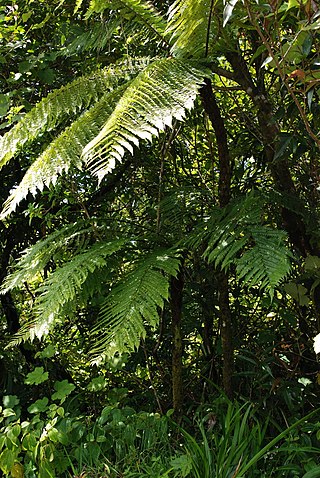
Alsophila borbonica, synonym Cyathea borbonica, is a tree fern endemic to Mauritius and Réunion. There are several natural forms and varieties.

Sphaeropteris robusta, synonym Cyathea robusta, is a fern in the family Cyatheaceae. The specific epithet alludes to its robust habit.

Sphaeropteris crinita, synonyms Alsophila crinita and Cyathea crinita, is a species of tree fern native to India and Sri Lanka. It is considered to be endangered.
Sphaeropteris ledermannii is a species of fern in the family Cyatheaceae, native to New Guinea. It was first described by Guido Brause in 1920 as Hemitelia ledermannii, and transferred to Sphaeropteris by Rolla Tryon in 1970.
Sphaeropteris rosenstockii is a species of tree fern in the family Cyatheaceae, native to New Guinea. It was first described by Guido Brause in 1920 as Cyathea rosenstockii, and transferred to Sphaeropteris by Rolla Tryon in 1970.
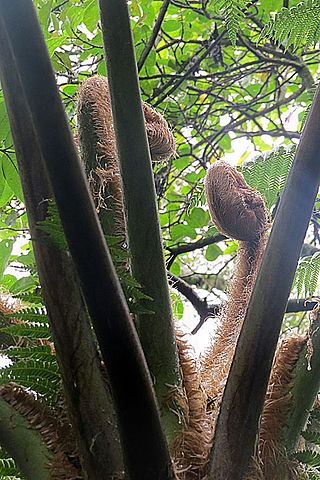
Sphaeropteris quindiuensis, is a species of tree fern in the family Cyatheaceae. It is native to Colombia, Ecuador, Peru and Bolivia.











